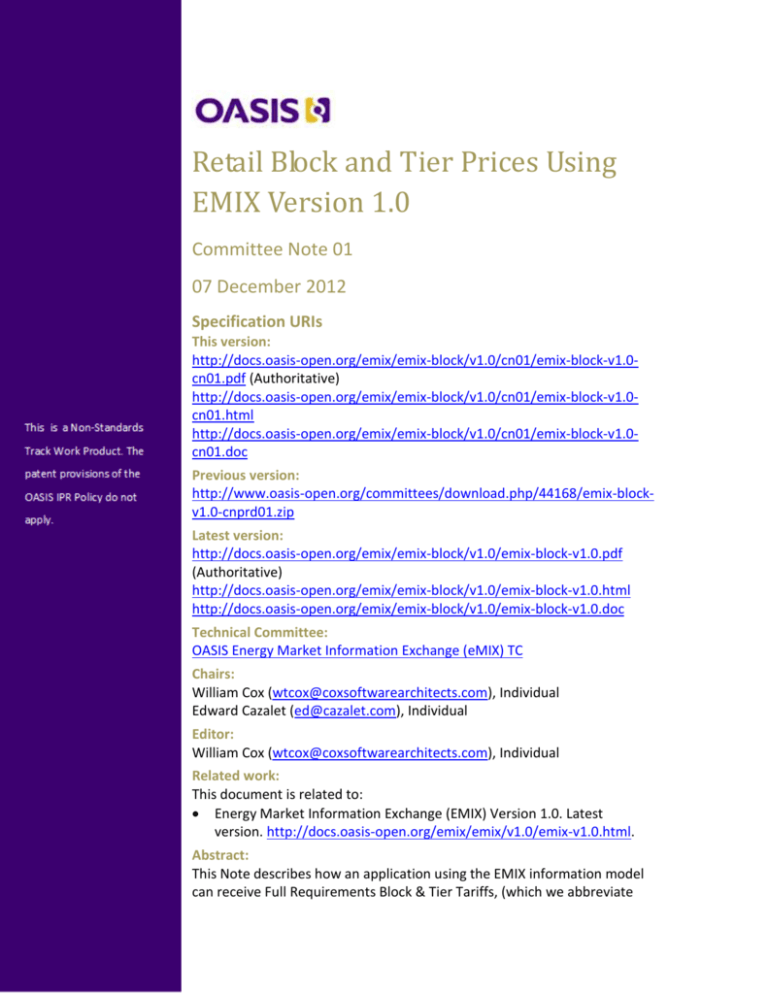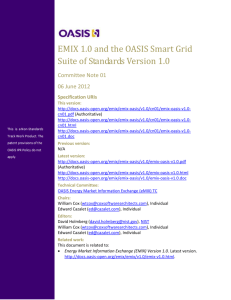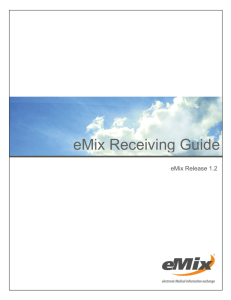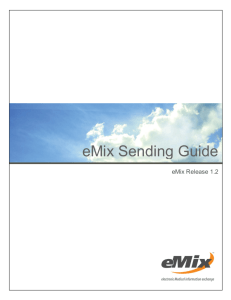
Retail Block and Tier Prices Using
EMIX Version 1.0
Committee Note 01
07 December 2012
Specification URIs
This version:
http://docs.oasis-open.org/emix/emix-block/v1.0/cn01/emix-block-v1.0cn01.pdf (Authoritative)
http://docs.oasis-open.org/emix/emix-block/v1.0/cn01/emix-block-v1.0cn01.html
http://docs.oasis-open.org/emix/emix-block/v1.0/cn01/emix-block-v1.0cn01.doc
Previous version:
http://www.oasis-open.org/committees/download.php/44168/emix-blockv1.0-cnprd01.zip
Latest version:
http://docs.oasis-open.org/emix/emix-block/v1.0/emix-block-v1.0.pdf
(Authoritative)
http://docs.oasis-open.org/emix/emix-block/v1.0/emix-block-v1.0.html
http://docs.oasis-open.org/emix/emix-block/v1.0/emix-block-v1.0.doc
Technical Committee:
OASIS Energy Market Information Exchange (eMIX) TC
Chairs:
William Cox (wtcox@coxsoftwarearchitects.com), Individual
Edward Cazalet (ed@cazalet.com), Individual
Editor:
William Cox (wtcox@coxsoftwarearchitects.com), Individual
Related work:
This document is related to:
Energy Market Information Exchange (EMIX) Version 1.0. Latest
version. http://docs.oasis-open.org/emix/emix/v1.0/emix-v1.0.html.
Abstract:
This Note describes how an application using the EMIX information model
can receive Full Requirements Block & Tier Tariffs, (which we abbreviate
This is a Non-Standards Track Work Product.
The patent provisions of the OASIS IPR Policy do not apply.
Block & Tier) and describes how the information can be used by any model rich enough
to encompass this sort of price information.
Status:
This document was last revised or approved by the OASIS Energy Market Information
Exchange (eMIX) TC on the above date. The level of approval is also listed above. Check
the “Latest version” location noted above for possible later revisions of this document.
Technical Committee members should send comments on this document to the
Technical Committee’s email list. Others should send comments to the Technical
Committee by using the “Send A Comment” button on the Technical Committee’s web
page at http://www.oasis-open.org/committees/emix/.
Citation format:
When referencing this document the following citation format should be used:
[emix-block-v1.0]
Copyright © OASIS Open 2012. All Rights Reserved.
All capitalized terms in the following text have the meanings assigned to them in the OASIS
Intellectual Property Rights Policy (the "OASIS IPR Policy"). The full Policy may be found at the
OASIS website.
This document and translations of it may be copied and furnished to others, and derivative
works that comment on or otherwise explain it or assist in its implementation may be prepared,
copied, published, and distributed, in whole or in part, without restriction of any kind, provided
that the above copyright notice and this section are included on all such copies and derivative
works. However, this document itself may not be modified in any way, including by removing
the copyright notice or references to OASIS, except as needed for the purpose of developing any
document or deliverable produced by an OASIS Technical Committee (in which case the rules
applicable to copyrights, as set forth in the OASIS IPR Policy, must be followed) or as required to
translate it into languages other than English.
The limited permissions granted above are perpetual and will not be revoked by OASIS or its
successors or assigns.
This document and the information contained herein is provided on an "AS IS" basis and OASIS
DISCLAIMS ALL WARRANTIES, EXPRESS OR IMPLIED, INCLUDING BUT NOT LIMITED TO ANY
WARRANTY THAT THE USE OF THE INFORMATION HEREIN WILL NOT INFRINGE ANY OWNERSHIP
RIGHTS OR ANY IMPLIED WARRANTIES OF MERCHANTABILITY OR FITNESS FOR A PARTICULAR
PURPOSE.
emix-block-v1.0-cn01
Non-Standards Track
Copyright © OASIS Open 2012. All Rights Reserved.
07 December 2012
Page 2 of 13
[Type the document title]
Retail Block and Tier Prices Using EMIX Version 1.0. 07 December 2012. OASIS
Committee Note 01. http://docs.oasis-open.org/emix/emix-block/v1.0/cn01/emixblock-v1.0-cn01.html.
This is a Non-Standards Track Work Product.
The patent provisions of the OASIS IPR Policy do not apply.
Table of Contents
1
Introduction ............................................................................................................................. 4
1.1 References ............................................................................................................................. 4
1.1.1 OASIS Committee Specifications and Drafts ................................................................... 4
1.1.2 Other References ............................................................................................................ 4
2
Block & Tier Prices ................................................................................................................... 5
2.1 Description of the Problem ................................................................................................... 5
2.2 Information Exchange............................................................................................................ 5
2.3 Scoping of the Problem ......................................................................................................... 6
Information Structure for Block & Tier .................................................................................... 8
3.1 EMIX Information Structure .................................................................................................. 8
3.2 SEP 2.0 Information Structure ............................................................................................... 8
3.3 Comparison of EMIX and SEP 2.0 Information Structures..................................................... 9
4
Summary and Conclusions ..................................................................................................... 11
Appendix A.
Acknowledgments ................................................................................................. 12
Appendix B.
Revision History ..................................................................................................... 13
emix-block-v1.0-cn01
Non-Standards Track
Copyright © OASIS Open 2012. All Rights Reserved.
07 December 2012
Page 3 of 13
[Type the document title]
3
1 Introduction
1
2
3
This Note describes how an application using the EMIX information model can receive Full
Requirements Block & Tier Tariffs, (which we abbreviate Block & Tier) and describes how that
information can be used by any model rich enough to encompass this sort of price information.
4
5
6
We describe the information for price inflection points, and then how that information is
expressed in EMIX 1.0 Public Review 04. In addition we show how the same information is
expressed in Smart Energy Profile 2 [SEP2], which has a rich price information model.
7
8
9
In EMIX information can be combined for a rich expression of anything from price and product
applied to a single interval to complex schedules over extended periods of time, with or without
gaps.
10
11
12
Any application that can express Full Requirements Block & Tier Tariff information can use that
application’s mapping to build a mapping from EMIX to its environment; if the artifacts are
expressed in XML in that application environment then an XSLT transformation may be created.
13
1.1 References
14
1.1.1 OASIS Committee Specifications and Drafts
15
16
17
[EMIX]
18
19
20
[EnergyInteroperation]
Energy Interoperation Version 1.0, 18 February 2012. http://docs.oasisopen.org/energyinterop/ei/v1.0/energyinterop-v1.0.html
21
22
23
[WS-Calendar]
OASIS WS-Calendar Version 1.0, 30 July 2011. OASIS Committee Specification. http://docs.oasisopen.org/ws-calendar/ws-calendar-spec/v1.0/cs01/ws-calendar-spec-v1.0-cs01.pdf
24
1.1.2 Other References
25
26
27
28
[SEP2]
Smart Energy Profile 2.0 Public Application Protocol Specification, Version 2.0 Draft 0.7 Third
Release, July 2011. ZigBee Alliance et al.
http://zigbee.org/Standards/ZigBeeSmartEnergy/Version20Documents.aspx
Energy Market Information Exchange (EMIX) Version 1.0. 11 January 2012.
http://docs.oasis-open.org/emix/emix/v1.0/emix-v1.0.html
29
2 Block & Tier Prices
30
31
32
33
34
In this section we describe California-style Block & Tier tariff information, and the price
inflection points that you need to know to determine prices. We describe Block & Tier price
inflection points and explore a specific example including how the example Block & Tier
information is expressed in EMIX [EMIX] and in SEP 2.0 [SEP2]. We use terminology for Intervals
and Gluons from [WS-Calendar].
35
36
We conclude by showing how any application environment that can express Block & Tier price
information can construct that information from an EMIX information exchange.
37
2.1 Description of the Problem
38
39
40
There are two or more Consumption Tiers, determined as a percentage of a baseline number,
which in turn is determined by the climate zone of the premises, hence is known for each
premises.
41
42
43
For concreteness in our example we assume that the baseline value is 1000 kWh, and that the
percentage amounts separating the tiers are at 100%, 150%, and 200%, defining four
Consumption Tiers.
44
45
For premises within a given Consumption Tier there is a price that depends on time of day. We
assume in our example diagrams that the times are:
46
Low
47
Shoulder/Mid 10am to 2pm and 6pm to 9pm
48
High
9pm to 10am the next day
2pm to 6pm
49
50
51
An application might deliver information for varying time ranges; we analyze the information
structure and note that the information content for (say) weekends would be expressed
similarly.
52
2.2 Information Exchange
53
54
55
56
57
58
EMIX is an integration information model, designed with building blocks to express common
characteristics of market information including price. One cannot assume that all
communicating applications will use precisely the same information models, so one must plan
for information mapping or transformation where the information is received. In EMIX,
information can be combined for a rich expression of anything from price and product applied to
a single interval to complex schedules over extended periods of time, with or without gaps.
59
60
61
A human gathers information from many sources, from newspapers, web pages, radio
broadcasts, and mail delivery of letters. Reading about the energy prices tomorrow in any of
those takes the information expressed in many different formats and media and is transformed
emix-block-v1.0-cn01
Non-Standards Track
Copyright © OASIS Open 2012. All Rights Reserved.
07 December 2012
Page 5 of 13
[Type the document title]
This is a Non-Standards Track Work Product.
The patent provisions of the OASIS IPR Policy do not apply.
62
63
into the information understanding in the human’s central nervous system. No one says, “I’ll
only read prices in the newspaper if they’re in precisely the format I like.”
64
65
66
67
Likewise a facility will receive information on energy prices tomorrow from web pages, radio
broadcasts, point-to-point messages, and other means. To act based on the semantic
information about price, the application must take information from multiple sources in
multiple formats.
68
69
70
71
72
73
One cannot assume that all recipients share precisely the same information modeling approach,
or that (even if they do) they change or update their models at exactly the same time. Complex
systems that do not take advantage of interchange or integration information can be brittle, and
hard to manage and evolve without a high level of care. By limiting the coupling between
provider and consumer information models, Service-Oriented Architectures allow for
independent evolution behind the information exchanged.
74
2.3 Scoping of the Problem
75
76
77
To demonstrate mapping to any Premises system that can handle the Blocks & Tiers, it suffices
to demonstrate expression of the information model required by those tariffs. We have in effect
an array where one dimension is Consumption Tier number and the other is time.
78
79
80
Consumption Tiers are defined by the cut points and identified by numbers 1, 2, 3, and 4 in the
following table. Time is defined by intervals. In the illustration the times are described as “Low,
Shoulder, and High” in Table 1.
Max
min
max
Consumption
Tier
Low
Shoulder
High
100% 150% 200% over
0
1000 1500 2000
1000 1500 2000 999999
1
0.10
0.20
0.30
2
0.11
0.25
0.50
3
0.12
0.27
0.60
4
0.13
0.32
0.65
81
T ABLE 1 PRICE IN DOLLARS PER K ILOWATT H OUR
82
83
84
85
This defines a two-dimension array; an application would find where it is in the Consumption
Tiers, and then read the price for the current or future time of day. So the key information is
exactly that, given the time of day and Consumption Tier, one can tell the Block & Tier aspect of
the current price1.
86
87
This array is expressed in EMIX, leveraging the structures for demand charges (industrial in the
US, residential and industrial in much of the rest of the world), as follows:
88
89
(1) Each time interval (Low, Shoulder, High) is described as a WS-Calendar Sequence, e.g.
a. Low: midnight to 10am and 9pm to midnight (two intervals)
1
Other charges may be in a bill, e.g., usage based or customer based; we are expressing the more
complex model for Block & Tier price only.
emix-block-v1.0-cn01
Non-Standards Track
Copyright © OASIS Open 2012. All Rights Reserved.
07 December 2012
Page 6 of 13
[Type the document title]
This is a Non-Standards Track Work Product.
The patent provisions of the OASIS IPR Policy do not apply.
This is a Non-Standards Track Work Product.
The patent provisions of the OASIS IPR Policy do not apply.
b. Shoulder: 10am to 2pm and 6pm to 9pm (two intervals)
c. High 2pm to 6pm (two intervals)
92
93
(2) In the alternative a sequence of intervals can be defined with the appropriate tier
information attached (starting at midnight, durations of 10h, 4h, 4h, 3h, 3h)
94
95
(3) Each time interval has a sequence of Consumption Tier cut points, expressed as
maximumEnergyLevel of the high point.
96
97
(4) Retrieval algorithm: Select the right time interval for time of day; select the correct
consumption tier.
98
99
100
101
Applications may choose to, and likely will, express this information differently. For example, an
array of 60-minute intervals could point to the Consumption Tier structure for that interval.
Moreover, an EMIX artifact could express the information in other ways, say with Gluons that
respectively reference the Low, Shoulder, and High price tiers.
102
103
104
105
Clearly this applies only to applications that maintain their own model of a Block & Tier tariff.
Since such an application has a means of interpreting the information model (cut points and
time intervals) that application can then describe the mapping from a received EMIX artifact to
its own information model.
106
107
More complex Block & Tier structures, e.g. ones with different price levels or consumption levels
on weekends or holidays, or seasonal differences can be expressed in a similar manner.
emix-block-v1.0-cn01
Non-Standards Track
Copyright © OASIS Open 2012. All Rights Reserved.
07 December 2012
Page 7 of 13
[Type the document title]
90
91
This is a Non-Standards Track Work Product.
The patent provisions of the OASIS IPR Policy do not apply.
3 Information Structure for Block & Tier
109
3.1 EMIX Information Structure
110
The EMIX information structure describes Intervals, each with a list of consumption tiers.
111
112
113
A Gluon references a Sequence [WS-Calendar] and contains inherited information such as
currency, units, scale, and what is measured. Thus each time Interval and ConsumptionTier has
common information.2
114
115
116
EMIX has a rich expression for price and product information. The mechanisms used for Block &
Tier are similar those that in EMIX are used to describe so-called ratchet tariffs, where exceeding
demand charge thresholds may affect price for months.
[Type the document title]
108
117
118
F IGURE 1 EMIX INFORMATION STRUCTURE FOR B LOCK & TIER EXAMPLE
119
3.2 SEP 2.0 Information Structure
120
121
We describe information structures from SEP2.0 Draft 0.7 – Third Release [SEP2], which
represents the Consumption Blocks & Tiers with a list of TimeTariffIntervals, each of which has
2
Unless a specific cell needs different information. For example, if many of the prices are 0.30, then
that value could be carried in the Gluon and inherited rather than expressed directly. The
information model is identical, but the expression may be compressed in this manner for
communication.
emix-block-v1.0-cn01
Non-Standards Track
Copyright © OASIS Open 2012. All Rights Reserved.
07 December 2012
Page 8 of 13
This is a Non-Standards Track Work Product.
The patent provisions of the OASIS IPR Policy do not apply.
zero or more ConsumptionTariffIntervals. This expresses the information in Table 1 as shown in
Figure 2 with time intervals across the top and the tier values in columns below.3
124
125
F IGURE 2 SEP2 INFORMATION STRUCTURE FOR B LOCK & TIER EXAMPLE
126
127
128
129
For clarity Figure 2 omits many details including inherited optional attributes. Consumption tiers
are represented by the minimum usage amount, which is apparently represented as startValue.
There is also the powerLimit in the RateComponent object, which is apparently the maximum
power permitted by the tariff.
130
3.3 Comparison of EMIX and SEP 2.0 Information Structures
131
132
The SEP2 information structure is very similar to the EMIX information structure. As we see the
graphical representation is essentially the same except for attribute names.
133
134
135
136
137
The EMIX tiers are identified using the maximum, rather than the minimum levels, so the series
in our example would be {1000, 1500, 2000, maximum allowable power which we abbreviate
maxPower}. In contrast, SEP2 tiers have additional information, determined by the Block & Tier
inflection point structure, apparently intended for application use, e.g. numPriceLevels that is
defined by the price inflection points.
138
139
140
There are other differences. For example, the following information items are represented in
the EMIX interchange information in the Gluon, and in the SEP2 application environment are in
an instance of the ReadingType class:
3
In this and other examples, optimization may be possible depending on how the application
software traverses the structure. Such optimizations do not affect our discussion.
emix-block-v1.0-cn01
Non-Standards Track
Copyright © OASIS Open 2012. All Rights Reserved.
07 December 2012
Page 9 of 13
[Type the document title]
122
123
This is a Non-Standards Track Work Product.
The patent provisions of the OASIS IPR Policy do not apply.
Currency
Energy as used in the definitions
Multiplier or scale factor
[Type the document title]
141
142
143
emix-block-v1.0-cn01
Non-Standards Track
Copyright © OASIS Open 2012. All Rights Reserved.
07 December 2012
Page 10 of 13
144
4 Summary and Conclusions
145
146
147
We have shown how both EMIX and SEP2 can express the information model of a Block & Tier
tariff. Any application that supports such tariffs can take and place the information on price
inflection points from an EMIX expression in its own data structures.
148
149
150
151
152
153
A concrete mapping can be made directly for any application environment that describes its
mapping of the Block & Tier tariffs. We have described in detail EMIX and SEP2 express Block &
Tier information. More generally, we have demonstrated that such a mapping exists from EMIX
to any application that supports Block & Tier tariffs—the same information mapping that the
application uses to express Block & Tier information is used to place the necessary price
inflection points in that application’s internal data structures.
154
155
156
This is the essence of constructing applications using Service Oriented Architectures and
integration approaches—the information gets through; how it’s maintained internally is the
business of the receiving application..
157
158
159
The process demonstrated, of understanding the application model and then mapping the
required information in to it, is also replicable for any target data structure that models Block &
Tier prices.
emix-block-v1.0-cn01
Non-Standards Track
Copyright © OASIS Open 2012. All Rights Reserved.
07 December 2012
Page 11 of 13
[Type the document title]
This is a Non-Standards Track Work Product.
The patent provisions of the OASIS IPR Policy do not apply.
This is a Non-Standards Track Work Product.
The patent provisions of the OASIS IPR Policy do not apply.
160
Appendix A. Acknowledgments
161
162
The following individuals have participated in the creation of this specification and are gratefully
acknowledged:
163
Participants:
164
165
166
167
168
169
170
171
172
173
174
175
176
Bruce Bartell, Southern California Edison
Edward Cazalet, Individual
Toby Considine, University of North Carolina
William Cox, Individual
David Holmberg, National Institute of Standards and Technology
William Cox, David Holmberg, and Don Sturek, OASIS Collaborative Energy
Standards, Facilities, and ZigBee Smart Energy, Grid-Interop 2011, Phoenix AZ,
December 2011.
emix-block-v1.0-cn01
Non-Standards Track
Copyright © OASIS Open 2012. All Rights Reserved.
07 December 2012
Page 12 of 13
[Type the document title]
Some contributions and techniques in this note were used, along with additional
examples related to SEP2 and demand response signals, as
This is a Non-Standards Track Work Product.
The patent provisions of the OASIS IPR Policy do not apply.
Appendix B. Revision History
Revision
Date
Editor
Changes Made
01
27
September
2011
Toby Considine
Template with notes
02
08 October
2011
William Cox
Rewrite from previously contributed
Block & Tier Information note.
03
13 October
2011
David Holmberg,
William Cox
Minor editorial corrections. Updated
footer numbers and WD numbers in
preparation for Public Review
04
11 April
2012
William Cox
Corrected diagrams. Referenced GridInterop paper.
05
12 June 2012
William Cox
Updated all references, and applied
minor editorial corrections
178
emix-block-v1.0-cn01
Non-Standards Track
Copyright © OASIS Open 2012. All Rights Reserved.
07 December 2012
Page 13 of 13
[Type the document title]
177











